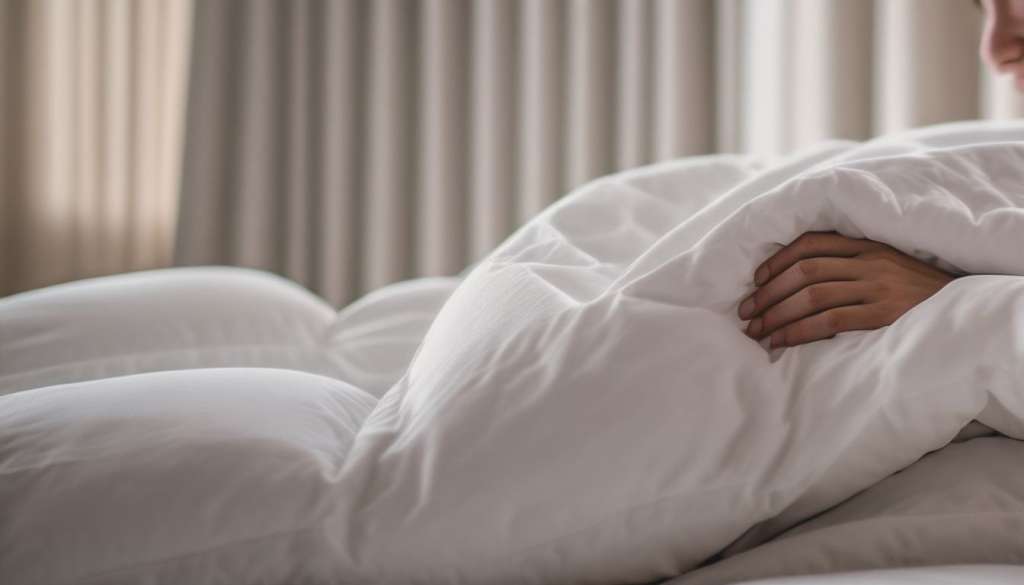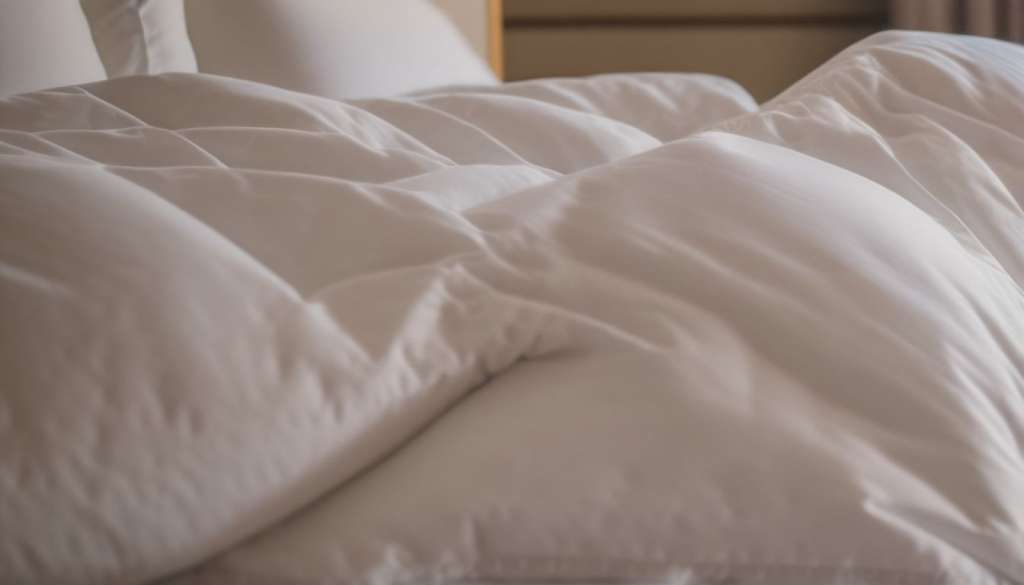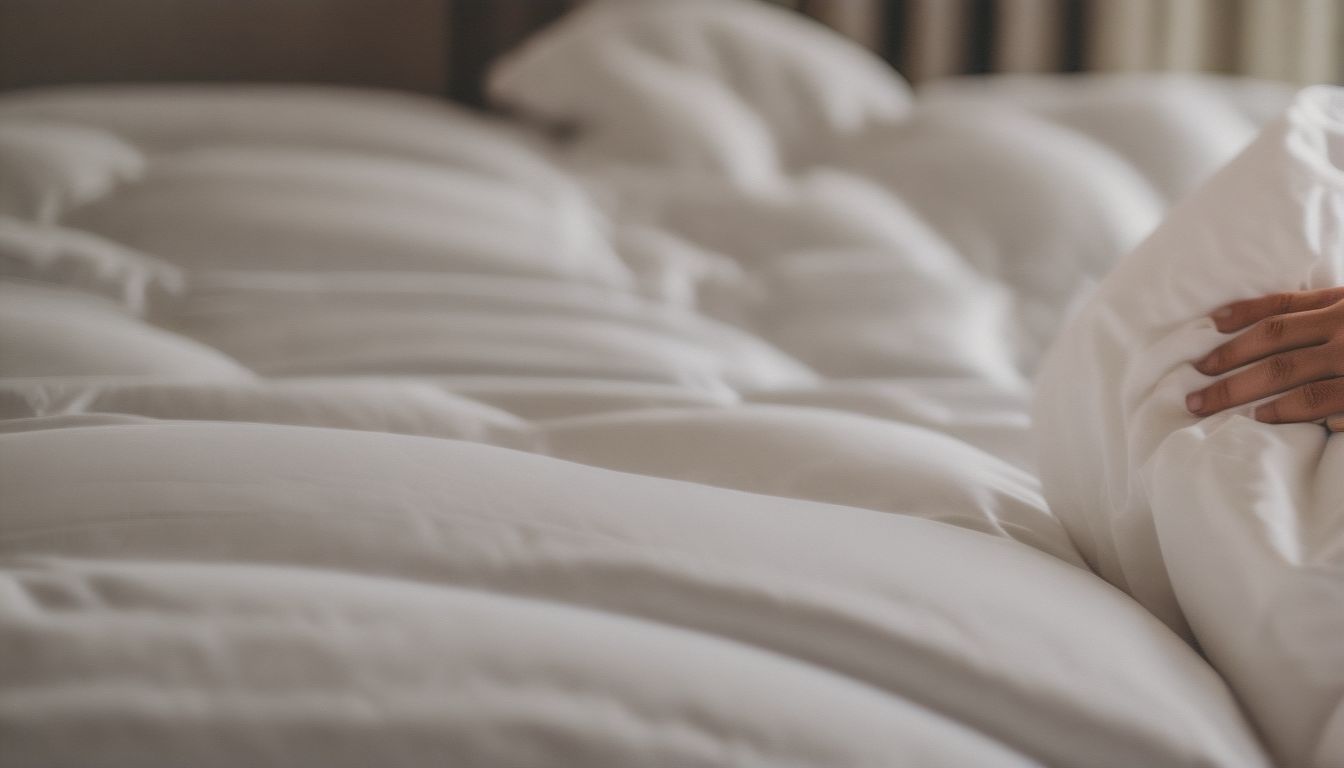Have you ever wondered why your down comforter makes so much noise? That crinkling sound whenever you move can be annoying. But it’s actually a sign of quality down filling.
This beginner’s guide will explain what causes down comforters to be crinkly, along with tips to reduce noise and maximize comfort. We’ll also compare down to alternatives like down-alternative comforters.
What Is a Down Comforter?
A down comforter is filled with the fine, fluffy clusters and plumules that come from ducks and geese. This superior insulation keeps you ultra-warm by trapping body heat without excess weight.
The filling is held in place by a shell fabric, most commonly cotton sateen or cambric cotton. Box stitching separates filling into baffled channels so it stays evenly distributed.
Why Are Down Comforters Noisy?
That signature crinkling noise comes from the unique structure of down filling. The 3D clusters don’t lay perfectly smooth – there’s loft between feathers. As they rub together and shift around, they create sound.
Down Cluster Movement
The spaces within and between down clusters allow comfortable airflow. But it also means filling can slide around with body movements, creating frictional noise against the shell fabric.
Some degree of crinkliness is inevitable with high fill power down since it contains larger, airier clusters than lower grades.
Low-Quality Filling and Fabrics
While some crinkling is normal, low-quality down products can be extra noisy:
- Feather quills mixed in can crackle sharply
- Downproofness issues lead to leakage through the fabric over time, increasing noise
- Loose-weave shell fabrics don’t contain sound as well as finely woven cotton
Tips to Reduce Down Comforter Noise
While you can’t eliminate crinkling entirely without compromising quality, you can minimize noise using advanced construction techniques:
1. Purchase Premium Down With High Fill Power
Higher fill powers like 700+ contain larger, whole clusters that move more quietly together. Avoid lower grades which use more broken-up feathers.
- Premium down fill starts around 600 fill power
- Ultra-premium ranges from 700-900+ fill power
2. Choose High Thread Count, Downproof Fabrics
Finely woven cotton sateen or cambric in the 300-600 thread count range better contains down. Special downproof finishing also prevents leakage over time.
3. Select Baffle Box Construction
This uses inner walls to divide filling into sections so it stays evenly distributed instead of shifting around. High-end brands like the Company Store Lacrosse Down Comforter utilize baffle box construction.
4. Carefully Wash and Dry
Follow instructions to gently clean down bedding. Use a large commercial machine, low heat tumble dry, and tennis balls to redistribute filling after each cycle.

How Does Down Compare to Alternative Comforters?
Down-alternative comforters substitute synthetic fibers to mimic down’s lightweight warmth, usually at a lower price point. Common types include:
- Primaloft
- Polyester microfiber
These materials don’t contain the same air pockets so they lay flatter and are less likely to make noise. However, alternatives can’t match the comforting sink-in feel and durability of real goose or duck down.
Down vs. Alternative Comparison Chart
| Factor | Down | Down-Alternative |
|---|---|---|
| Warmth | Excellent, adjustable | Good |
| Lightweight | Yes | Yes |
| Noise | Some crinkling | Minimal noise |
| Allergy-Friendly | No, contains allergens | Yes |
| Price | $$$ | $ |
| Lifespan | 10+ years if cared for | 5-8 years typically |
When Is Crinkling Cause for Concern?
While some noise is expected with down bedding, excessive crinkling or cracking likely signals an issue:
- Cheap fabrics allowing fill leakage
- Low fill power with broken feathers
- Uneven fill distribution
- Loss of loft and warmth over time
In these cases, it’s best to replace the comforter to restore peaceful nights.
Conclusion
A certain level of crinkling comes with luxurious down bedding. But low-quality materials and construction can make comforters annoyingly noisy. By selecting premium components like high fill power down, fine thread count fabrics, and baffle box stitching, you can minimize noise for dreamy, undisturbed sleep.
What down comforter questions do you still have? Ask them below!

Frequently Asked Questions
What is the difference between a duvet and down comforter?
A duvet is a decorative bed cover used with a removable insert for convenience. The insert is usually a down or down-alternative comforter providing insulation. Duvets make it easy to change covers but do not reduce down comforter noise.
How warm do down comforters rate?
Down comforters are assigned warmth “tog” ratings based on insulation ability. Common levels are:
- Light warmth: Less than 4.5 tog
- All-season usage: 4.5-7.5 tog
- Ultra-warm for cold weather: 7.5+ tog
Higher fill power down tends to have increased warmth capabilities.
Should I get a down or down-alternative comforter?
Down comforters are preferable if you want lightweight breathability, crisp loft that contours your body, and long-term durability. The tradeoff is a higher price tag and potential allergies. Down-alternative comforters are cheaper, hypoallergenic, and require less care but don’t last as long.
How do I wash a down comforter to prevent noise?
Use a large, commercial washer on a gentle setting. Dry with tennis balls on low heat to re-fluff filling. Improper washing can lead to clumping or shifting of down which increases noise over time.
What fabric weave is ideal for down comforters?
Tightly-woven sateen cotton or cambric with a thread count over 300 provides necessary downproofness while allowing airflow. Special downproof finishing can augment leakage protection.








